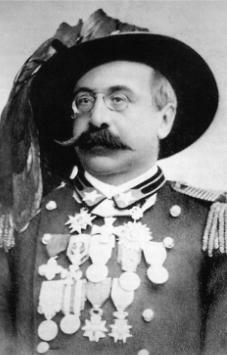Oreste Baratieri facts for kids
Quick facts for kids
Oreste Baratieri
|
|
|---|---|
 |
|
| Governor of Eritrea | |
| In office 1892–1896 |
|
| Personal details | |
| Born | 13 November 1841 Condino, Austria-Hungary |
| Died | 7 August 1901 (aged 59) Sterzing, Austria-Hungary |
| Military service | |
| Branch/service | Italian Army |
| Rank | Major General |
| Battles/wars |
|
Oreste Baratieri (born November 13, 1841 – died August 7, 1901) was an Italian general. He also served as the governor of Italian Eritrea, a colony in Africa. He is best known for leading Italian forces during the First Italo–Ethiopian War.
Early Military Career
Oreste Baratieri was born in Condino, which was part of Austria-Hungary at the time. He started his military journey as a volunteer. He joined Giuseppe Garibaldi's "Redshirts." These were brave fighters who helped unite Italy between 1860 and 1861.
After Italy became a united country, Baratieri continued his military path. He joined the regular Italian Army. He fought in important battles, like the Battle of Custoza in 1866.
By 1891, Baratieri had become a general. The next year, he was chosen to lead Italian troops in Africa. He also became the governor of Eritrea. For several years, from 1893 to 1895, he fought against local forces near the border with Ethiopia. He won several battles against the Mahdists, especially at the Battle of Kassala in 1894.
The Italo-Ethiopian War
A disagreement grew between Italy and Ethiopian Emperor Menelik II. This was about a treaty they had signed. Italy decided to invade the Ethiopian Empire. General Baratieri briefly returned to Italy. He reportedly told crowds he would bring Emperor Menelik back in a cage.
In late 1895, Baratieri led about 25,000 Italian soldiers into Ethiopia. Many of these soldiers were Eritrean Ascari, who were local troops fighting for Italy. However, Emperor Menelik II had prepared his army well. He had spent years getting modern weapons and ammunition. His army was much larger than the Italian forces.
Baratieri tried to avoid a major battle for almost a year. He hoped the Ethiopian army would run out of supplies and break up. But in February 1896, the Italian government, led by Francesco Crispi, ordered Baratieri to attack. What Baratieri didn't know was that the government had already decided to replace him. His replacement, General Baldissera, was already on his way.
On February 28, 1896, Baratieri met with his commanders. He thought it would be better to pull back some troops. But his commanders and orders from Rome insisted on moving forward into the mountains.
On February 29, Baratieri marched his troops in four separate groups towards the Ethiopians at Adowa. His immediate command had about 9,894 men. The Ethiopian army outnumbered them by more than ten to one. The fighting started early on March 1. Ethiopian forces were in a strong position. By noon, the battle was mostly over.
About 14,660 Italian and Eritrean soldiers were killed during the war. Baratieri's forces suffered heavy losses, with two-thirds of his men killed or wounded in the battle. As a result of this terrible defeat, Italy had to sign the Treaty of Addis Ababa. This treaty officially recognized Ethiopia as an independent country.
After the disaster, Baratieri faced a military trial in Asmara. He was found not guilty, but he had to leave his position the next year. He spent the rest of his life living quietly in Austria. He passed away on August 7, 1901.
See also
 In Spanish: Oreste Baratieri para niños
In Spanish: Oreste Baratieri para niños


